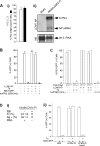Inhibition of the type I interferon response by the nucleoprotein of the prototypic arenavirus lymphocytic choriomeningitis virus
- PMID: 16940530
- PMCID: PMC1563941
- DOI: 10.1128/JVI.00555-06
Inhibition of the type I interferon response by the nucleoprotein of the prototypic arenavirus lymphocytic choriomeningitis virus
Abstract
The prototypic arenavirus lymphocytic choriomeningitis virus (LCMV) is a formidable battle horse for the study of viral immunology, as well as viral persistence and associated diseases. Investigations with LCMV have uncovered basic mechanisms by which viruses avoid elimination by the host adaptive immune response. In this study we show that LCMV also disables the host innate defense by interfering with beta interferon (IFN-beta) production in response to different stimuli, including infection with Sendai virus and liposome-mediated DNA transfection. Inhibition of IFN production in LCMV-infected cells was caused by an early block in the IFN regulatory factor 3 (IRF-3) activation pathway. This defect was restored in cells cured of LCMV, indicating that one or more LCMV products are responsible for the inhibition of IRF-3 activation. Using expression plasmids encoding individual LCMV proteins, we found that expression of the LCMV nucleoprotein (NP) was sufficient to inhibit both IFN production and nuclear translocation of IRF-3. To our knowledge, this is the first evidence of an IFN-counteracting viral protein in the Arenaviridae family. Inhibition of IFN production by the arenavirus NP is likely to be a determinant of virulence in vivo.
Figures







References
-
- Baize, S., J. Kaplon, C. Faure, D. Pannetier, M. C. Georges-Courbot, and V. Deubel. 2004. Lassa virus infection of human dendritic cells and macrophages is productive but fails to activate cells. J. Immunol. 172:2861-2869. - PubMed
-
- Beutler, B. 2004. Innate immunity: an overview. Mol. Immunol. 40:845-859. - PubMed
Publication types
MeSH terms
Substances
Grants and funding
LinkOut - more resources
Full Text Sources
Other Literature Sources
Miscellaneous

